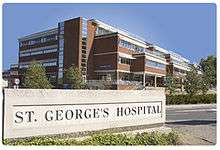Caroline Moore (academic)
Caroline M. Moore is the first woman to be made a professor of urology in the United Kingdom. She works in the diagnosis and treatment of prostate cancer at University College London.
Caroline M. Moore | |
|---|---|
| Occupation | Urologist |
| Academic background | |
| Education | St George's, University of London |
| Thesis | "Photodynamic therapy for Prostate Cancer" (2007) |
| Academic work | |
| Institutions | University College London University College London Hospital |
Her research on evaluating photodynamic therapy for prostate cancer, became the subject of her MD, which was completed in 2007, and led to the first completed randomised trial comparing focal treatment for prostate cancer with active surveillance.
Early life and education

Caroline Moore was born in Chester, and moved to Wombourne at the age of five. She was educated at St. Edmunds Catholic College before gaining admission to study medicine at St George's Hospital Medical School, London, from where she graduated in 1997.[1]
Research and career

After completing her early medical training in London, she gained membership of the Royal College of Surgeons, who subsequently awarded her a research fellowship. Her research began in 2002 on evaluating photodynamic therapy for prostate cancer. It became the subject of her MD, which was completed in 2007, and led to the first completed randomised trial comparing focal treatment for prostate cancer with active surveillance. Later, she published the first study using magnetic resonance imaging (MRI) to evaluate treatment in early prostate cancer.[1][2][3]
Moore started using MRI to detect prostate cancer in men who would not need treatment, and found that if biopsies were performed before MRI scans the images were blurred.[4]
In October 2012 she established a committee on Standards in Reporting in MRI-targeted biopsy (START).[5] The recommendations included reporting histologic results of standard cores using Gleason scores and maximum core cancer length, as well as reporting the recruitment criteria, radiologist experience and population biopsy status of a particular trial.[5] She has worked on a combination of multi-parametric MRI and cognitive fusion transperineal biopsy, which can reduce the time taken diagnose and treat diseases.[6] She has found that using MRI can reduce the need for biopsies by 28%.[7][8][9] In 2019, her MRI protocols were approved by the National Institute for Health and Care Excellence (NICE), and incorporated into national guidance for the investigation of men suspected of having clinically localised prostate cancer.[10]
Moore has developed electronic psychometric patient-reported outcome measures to monitor men who have had radical prostatectomy.[11] Men who have this surgery can suffer from urinary leakage and difficulties with erections. The survey allows researchers to track their progress and share information with their surgical teams.[12] Moore has been among a group of researchers spread across six hospitals who have been investigating high-intensity focused ultrasound (HIFU) as a treatment for prostate cancer. Five years after treatment with HIFU the cancer survival rate is 100%, the same as for the more traditional methods of surgery and radiotherapy, but with fewer side-effects.[13]
She has been Head of Urology at University College London, within the Division of Surgical and Interventional Sciences since 2018. She was senior author on the Prostate Evaluation for Clinically Important Disease: Sampling Using Image Guidance or Not? (PRECISION) study comparing standard prostate biopsy and MRI-targeted biopsy.[11][14][15][16]
In 2019 Moore was the first woman in the United Kingdom to be made a Professor of Urology.[1] Her research has been supported by Prostate Cancer UK, the Movember Foundation, the Cancer Vaccine Institute, the National Institute for Health Research, the European Association of Urology Research Foundation, the Wellcome Trust and the Department of Health.[2][17]
Other roles
She serves on the board of the European Association of Urology Research Foundation.[18]
She has served as a science consultant for the science comic Surgeon X.[19]
Personal and family
Moore has four children.[1]
Selected publications
- "Image-Guided Prostate Biopsy Using Magnetic Resonance Imaging–Derived Targets: A Systematic Review". European Urology. 63 (1): 125–140. January 2013. doi:10.1016/j.eururo.2012.06.004. PMID 22743165. (Joint author)
- "Standards of reporting for MRI-targeted biopsy studies (START) of the prostate: recommendations from an International Working Group". European Urology. 64 (4): 544–552. October 2013. doi:10.1016/j.eururo.2013.03.030. ISSN 1873-7560. PMID 23537686.CS1 maint: date and year (link) (Joint author)
- "Standards of reporting for MRI-targeted biopsy studies (START) of the prostate: recommendations from an International Working Group". European Urology. 64 (4): 544–552. 2013. doi:10.1016/j.eururo.2013.03.030. ISSN 1873-7560. PMID 23537686. (Joint author)
- "Prostate cancer diagnostic pathway: Is a one-stop cognitive MRI targeted biopsy service a realistic goal in everyday practice? A pilot cohort in a tertiary referral centre in the UK". BMJ Open. 8 (10): e024941. October 2018. doi:10.1136/bmjopen-2018-024941. ISSN 2044-6055. PMC 6224764. PMID 30361408. (Joint author)
- "MRI-Targeted or Standard Biopsy for Prostate-Cancer Diagnosis" (PDF). The New England Journal of Medicine. 378 (19): 1767–1777. 10 May 2018. doi:10.1056/NEJMoa1801993. ISSN 1533-4406. PMID 29552975. (Joint author)
References
- Jones, Helen (13 August 2019). "Role model: Caroline Moore". British Medical Journal. 366. doi:10.1136/bmj.l4826. ISSN 0959-8138. PMID 31409589.
- "Professor Caroline Moore". www.uclh.nhs.uk. University College London Hospitals. Retrieved 29 May 2020.
- "Dr Caroline Moore - Supervisors - UCL EPSRC Centre for Doctoral Training In Medical Imaging". medicalimaging-cdt.ucl.ac.uk. Retrieved 29 May 2020.
- Moore, Caroline Monitoring and treating prostate cancer on YouTube 10 July 2018
- Moore, Caroline M.; Kasivisvanathan, Veeru; Eggener, Scott; Emberton, Mark; Fütterer, Jurgen J.; Gill, Inderbir S.; Grubb Iii, Robert L.; Hadaschik, Boris; Klotz, Laurence (2013). "Standards of reporting for MRI-targeted biopsy studies (START) of the prostate: recommendations from an International Working Group". European Urology. 64 (4): 544–552. doi:10.1016/j.eururo.2013.03.030. ISSN 1873-7560. PMID 23537686.
- Bass, Edward James; Freeman, Alex; Jameson, Charles; Punwani, Shonit; Moore, Caroline M; Arya, Manit; Emberton, Mark; Ahmed, Hashim Uddin (October 2018). "Prostate cancer diagnostic pathway: Is a one-stop cognitive MRI targeted biopsy service a realistic goal in everyday practice? A pilot cohort in a tertiary referral centre in the UK". BMJ Open. 8 (10): e024941. doi:10.1136/bmjopen-2018-024941. ISSN 2044-6055. PMC 6224764. PMID 30361408.
- "MRI for prostate cancer diagnosis could change clinical practice | UCLH Biomedical Research Centre". www.uclhospitals.brc.nihr.ac.uk. Retrieved 2019-03-30.
- Malewar, Amit (5 July 2018). "Prostate cancer ultrasound treatment as effective as surgery or radiotherapy". Tech Explorist. Retrieved 29 May 2020.
- "Study finds prostate MRI scans both increase detection of cancer and reduce over-diagnosis". www.birmingham.ac.uk. 19 March 2018. Retrieved 2019-03-30.
- UCL (10 May 2019). "Prostate cancer guidelines changed to reflect UCL trial findings". UCL News. Retrieved 2 June 2020.
- "Frontiers of Oncology | Caroline Moore". University College London. Retrieved 2019-03-30.
- Moore, Caroline M. "True NTH UK – Post Surgical Follow up". Health Research Authority. Retrieved 2019-03-30.
- Wighton, Kate (4 July 2018). "Prostate cancer ultrasound treatment as effective as surgery or radiotherapy". Imperial News. Imperial College London. Retrieved 2019-03-30.
- UCL (19 October 2018). "Caroline Moore". UCL School of Life and Medical Sciences. Retrieved 29 May 2020.
- "EAU 2018: Major Study Shows Prostate MRI Reveals More Cancers Which Need Treatment and Reduces Overdiagnosis Compared to Standard Biopsy". UroToday. 2018. Retrieved 2019-05-13.
- Vega, Joel (19 March 2018). "PRECISION: MRI-targeted biopsy strategy leads to fewer men needing biopsy - EAU18 Copenhagen". EAU20 Virtual. Retrieved 2 June 2020.
- "Movember Global Outcomes Project | Macmillan Survivorship Research Group | University of Southampton". www.southampton.ac.uk. University of Southampton. Retrieved 29 May 2020.
- Professionals, Sumedia-Online. "The EAU Research Foundation". Uroweb. Retrieved 2019-05-11.
- Sara Kenney (30 November 2016). Surgeon X #3. Image Comics. pp. 2–. PKEY:SEP160761.
- Mandal, Ananya (9 June 2019). "Prostate cancer diagnosis gets a boost from MRI". News-Medical.net. Retrieved 1 June 2020.
External links
- Caroline Moore publications indexed by Google Scholar
- Miss Caroline Moore profile